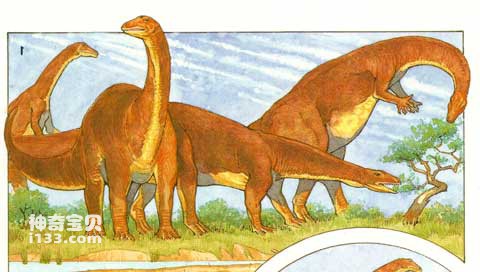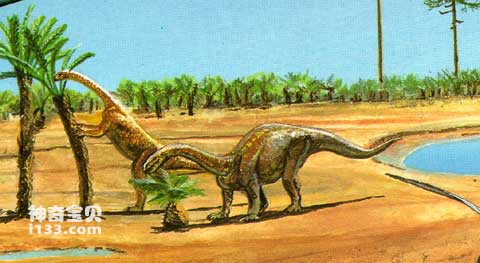Less than 15 million years after the earliest dinosaurs - those small carnivores - appeared, plant-eating vegetarian dinosaurs began to appear 215 million years ago. Among the fern forests and evergreen trees beside the river and lake. At that time, it was still in the late Triassic period geologically. These vegetarian dinosaurs had grown quite huge and had become the largest animals in the world at that time. However, over the next 100 million years or so, vegetarian dinosaurs would grow even larger.

Plateosaurus

Plasosaurus climbs trees with its forelimbs to feed on leaves on tall trees
Plateosaurus is the most important representative of these earliest vegetarian dinosaurs. This dinosaur can reach 6 to 8 meters in length and weighs 1 to 2 tons. They are paleopods.
The skull of Plateosaurus is very strong, but it is small compared with such a large body. Correspondingly, the mouth is also small, that is, the upper and lower jaws are small. Their jaws have many small leaf-like teeth. These teeth are flat and flat, with some small serrations on the edges. They can be used well for tearing plants, but they are obviously unable to effectively chew the plants they bite into their mouths. food. So how do they digest enough food to provide the nutritional and energy needs of such a large body? It turns out that, like many vegetarian birds, they rely on crops. The crop of Plateosaurus is not small, bigger than a basketball. Moreover, there are gastroliths in the crop, which can easily grind up the hard plants that are swallowed.
Dozens of dinosaur fossil skeletons were unearthed from the late Triassic rock formations in many quarries in central Europe. These dinosaurs were almost all Plateosaurus. Many Plateosaurus fossils preserve intact thigh bones, often standing upright in the rock formations. This unusual posture suggests that these dinosaurs were standing when they died and that they remained in that standing position after death. I don't know why they didn't fall down. Perhaps they were caught and stuck in this position by the silt of the time, which turned into mudstone hundreds of millions of years later.
The hind legs of Plateosaurus are longer and stronger than the forelimbs, so scientists speculate that they relied on their hind legs to support their 2-ton body and walk. The weight of the head and forelimbs was balanced by a heavy tail, and their large tail The heavy stomach is located almost at the center of gravity of the body.
The forelimbs of Plateosaurus may have served several purposes. The thick front paw has a thumb and four other ordinary fingers. The thumb has a large claw with a pointed top. Some scientists believe that the large claws on the thumb were used for defense against predators, while others believe they were used for grabbing food from trees or shrubs. Maybe, a bit of both jobs.
But compared with those carnivorous dinosaurs, the forelimbs of Plateosaurus are much thicker. Therefore, some scientists speculate that Plateosaurus has begun to tend to walk on four legs. However, when they want to feed on leaves on higher trees, they can use their hind legs to support themselves on the ground and use their forelimbs to climb the trunk to reach higher leaves.
Because Plateosaurus skeletons are often found in groups, many scientists speculate that the animals lived in small groups, like modern hippos and Elephants-Are-Endangered.html">elephants.
animal tags:
We created this article in conjunction with AI technology, then made sure it was fact-checked and edited by a Animals Top editor.